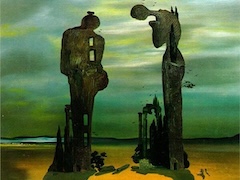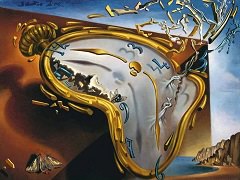Spider of the Evening 1940 by Salvador Dali

Dali's familiar landscape is here denuded. The olive tree, emblem of peace, is stripped of its leaves, and the Italianate figures in the background seem to dance the Sardana of death, their shapes and their ballooning sleeves echoing the languid forms draped across the foreground. Dark shadows, suggestive of the evening, cling to the objects and give a sense of loss. This whole melting spectacle is lamented by a winged putto, symbol of love, and of artistic pursuits, who sits weeping in the bottom left corner. This putto, recalling the weeping cupid in Felicien Rops's Pornocrates, suggests the meaning of this painting, which depicts another sort of pornography, the pornography of war. Set in the devastation of World War II, which Dali and Gala had recently fled, this work allegorizes the emotional effects of great human upheaval. It is a theater of conflict whose prologue Dali had already seen in the Spanish Civil War and which he would describe in The Secret Life:
Throughout all martyred Spain arose an odor of incense, of the burning flesh of priests, of spiritual quartered flesh, mixed with the powerful smell of the sweat of mobs fornicating among themselves and with Death."
Painted in 1940 amid fears of even greater carnage, this work extends the imagery of Dali's Persistence of Memory of 1931, now offering us a compendium of cultural enervation world grown hostile to the artistic effort.
The total impression of this disturbing painting, inspired, like Guernica, 1937 of Pablo Picasso, by the carnage of war, combines lassitude and decay with a sense of remorse. Dali's inclusive imagination sees these different qualities all playing a part within a cultural tragedy.























